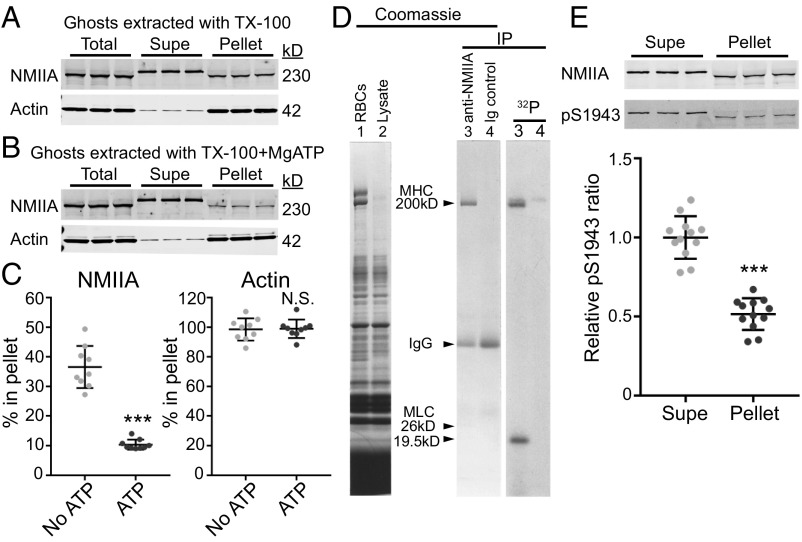Fig. 2.
NMIIA association with the RBC membrane skeleton is MgATP-dependent, and NMIIA HC and RLC phosphorylation indicates active regulation of NMIIA motor activity and filament assembly at the membrane skeleton. Human RBC Mg2+ ghosts were extracted in TX-100 buffer without (A) or with (B) addition of 5 mM MgATP, followed by SDS/PAGE and immunoblotting for NMIIA HC or actin in the soluble (Supe) and insoluble membrane skeleton (Pellet) fractions. The decreased mobility for the NMII HC in ghosts and TX-100–extracted pellet samples on these acrylamide gradient minigels is due to the large excess of spectrin over NMIIA HC, which forces the HC to migrate faster and is not observed on large-format, low-percentage gels (Fig. S3). (C) Quantification of the percentage of NMIIA or actin in the membrane skeleton fraction. A portion of NMIIA (36.5 ± 7.1%) is in the TX-100–insoluble pellet in the absence of MgATP, and 10.4 ± 1.7% is in the pellet in the presence of MgATP (***P < 0.0001). Most of the actin (98.5 ± 7.5%) is in the TX-100–insoluble pellet with no ATP, and 98.9 ± 6.25% is in the pellet with ATP. Each point represents one of three technical replicates for each of three biological replicates (ghosts from three donors), for a total n = 9. Lines represent mean ± SD. N.S., not significant. (D) Live human RBCs were metabolically labeled with 32P-orthophosphate to detect phosphorylated proteins and lysed, and native NMIIA was immunoprecipitated under nondenaturing conditions. (Left) Coomassie Blue gel of total RBCs (lane 1) and lysate before immunoprecipitation (IP; lane 2). (Right) Coomassie Blue gel of anti-NMIIA IP (lane 3) and preimmune IgG IP (lane 4), and autoradiogram of this gel. The RBC NMIIA 26-kD essential light chain and 19.5-kD RLC were visible in the original Coomassie-stained gel but faded upon destaining (15). (E) Human RBC Mg2+ ghosts were extracted in TX-100 buffer, followed by SDS/PAGE and immunoblotting for NMIIA HC (Top) or NMIIA HC phosphorylated on serine 1943 (pS1943; Bottom). Quantification shows that the ratio of pS1943 HC/total HC is about twofold higher in the TX-100–soluble supernatant (mean ± SD = 1.0 ± 0.13) compared with the TX-100–insoluble pellet (mean ± SD = 0.52 ± 0.10). Each point represents one of three technical replicates for each of four biological replicates (four individual donors), for a total n = 12 (***P < 0.0001). Lines represent mean ± SD.

